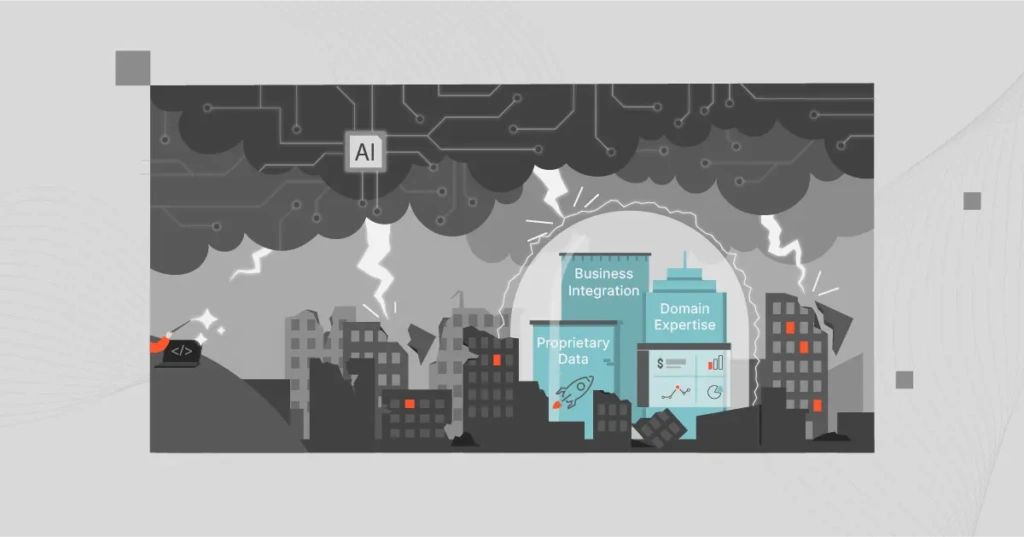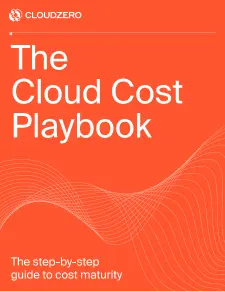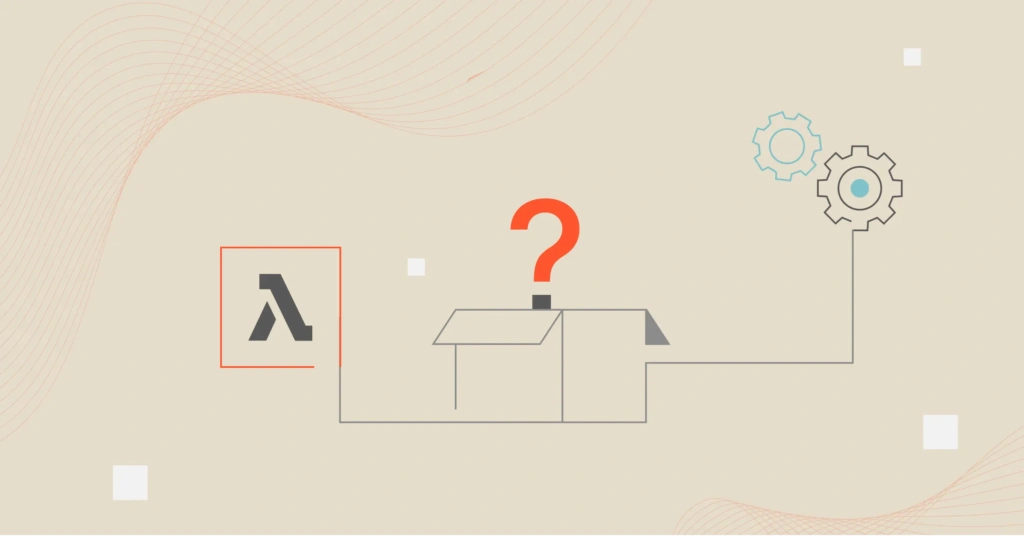At CloudZero’s most recent company retreat, we held an investor panel, where representatives from four of the VC firms investing in CloudZero fielded questions from our team. Unsurprisingly, a good deal of the conversation revolved around AI.
A standout moment from this panel came when one investor described a vibe coding session he’d done about a month prior. “Vibe coding,” for the uninitiated, means using AI to build an application without writing any actual code yourself. (It bears mentioning that this person was not a software engineer.)
“Half a bottle of wine later,” he said, “I’d built an application that mirrored much of the functionality of a company we were considering investing in.”
It was a mic drop moment. If a non-engineer — albeit one with a lot of experience working with SaaS companies — could build an application like that in a merely semi-intoxicated vibe coding session, what did that say about the future of SaaS?
As Bob Dylan said, “The carpet … is moving under you.”
3 Main Threats To The SaaS Business Model
The SaaS revolution was driven by two concurrent innovations: 1. The delivery model (much of which was predicated on the cloud); and 2. The underlying business model.
For legacy technologies, you’d buy a perpetual license and then pay annual maintenance fees (for bug fixes and other updates) — picture $100 upfront and $20 every year in maintenance fees. SaaS set up a recurring revenue model where you just paid $50 per year, and for that subscription fee, you got automatic, rolling platform updates and the benefit of advanced functionality that would be either impossible or highly inefficient to build on their own. Plus, the SaaS provider would host the solution, alleviating the infrastructure headache and the need to manage upgrades.
Software margins suffered a bit — mid-80s became the SaaS benchmark versus the mid-90s that legacy models provided — but revenue was higher, and end-users much preferred the convenience.
But what about now? If companies can easily build the software and host it in the cloud themselves, it could topple the whole SaaS structure. Three major go-to-market (GTM) threats emerge:
- New logo lands. As software gets easier to build, we’ll begin to see customers building their own replicas of SaaS products, and buying less new software (Klarna, for example, vowed to replace all SaaS products with AI). We’ll also see spaces get flooded with competitors who, at least in the short term, will threaten to steal some revenue from more established vendors.
Potential impacts: Fewer new customers, reduced new revenue. - Existing customer retention. Existing customers may not renew — and if they do, the easier access to viable substitutes could hurt your pricing power.
Potential impacts: Higher customer churn, more downsells, reduced revenue. - Existing customer expansion. Even if existing customers can’t replace your core software, they might be able to replace the knobs you use for upsell. Moreover, the rise in autonomous AI agents might mean customers buy fewer user licenses.
Potential impacts: Less expansion, lower net revenue retention.
None of these shifts will happen overnight. But we’ve already seen companies start to take bigger risks with homegrown solutions and apply pressure to SaaS companies’ bottom lines. The writing on the wall is clear: AI is threatening to displace SaaS products that can’t defend their differentiation.
But of course, they don’t have to take these threats lying down.
3 Ways SaaS Companies Can Defend Themselves
SaaS vendors have three major bargaining chips that it will be difficult or impossible for customers to replicate with AI.
- Domain experience. SaaS providers have deep wells of experience building software and driving value realization in their domain. SaaS value doesn’t just come from workflows, dashboards, and Sankey diagrams; there’s also a consultative element of value that can only come from experience in the space.
- Data. SaaS providers have access to an enormous amount of data on individual customers and their space as a whole, that, if leveraged well, can serve as a tremendous moat against homemade solutions.
These stores of data give SaaS providers opportunities for machine learning (ML), benchmarking, and recommendations, both within individual customers and across their customer base. They also expose customers to the benefits of network effects that customers would not be able to implement if they were building solutions on their own. - Business integration. As anyone who understands the best practices of implementing software will tell you, it’s the convergence of people, process, technology, and governance that drives adoption and value realization.
Using AI to build the software is only a small part of the work. Integrating the software into your business processes, training users on adopting it, supporting end-users when they need help, integrating multiple systems in a way that aligns to your internal workflows, and even driving the accountability that a contract renewal or procurement process brings all fall under the broad, complex umbrella of business integration.
The Impending SaaS Margin Shift
Because SaaS vendors still have a lot to defend themselves with, I don’t see this as a death knell for SaaS as a whole. The best SaaS platforms still have deeply differentiated offerings that even the grooviest vibe coding sessions won’t be able to replicate. But SaaS companies won’t get out unscathed.
Sustaining and leveraging these differentiators — domain expertise, data, and business integration — will be costly. Storing, managing, and processing data is extremely expensive, especially if you’re using AI or ML. So is building software that maintains seamless business integration, and so is adding headcount to do all of the above. These costs will compound revenue pressures (customer acquisition, retention, and expansion) with expense pressures.
The net result? A(nother) paradigm shift in how SaaS companies are valued.
In their heyday, elite SaaS companies commanded gross margins in the mid-80s or more. As SaaS greenfield dwindled, that dropped to the mid-70s. Now, amid AI-driven pressures on both revenue and expenses, I anticipate the standard gross margin of elite SaaS companies to drop again, to the mid-60s.
As margin expectations shift, SaaS companies will face pressure to cling to every shred of margin they can. They’ll need to reduce their costs, by driving cloud and AI cost efficiency through initiatives like containerization and multi-tenancy. They’ll need to maintain as much top-line revenue as they can through effective pricing and discount programs.
To do so, they’ll need elite clarity on what it costs to generate their revenue.
How To Maximize Cloud-Driven Profit In The AI Era
There are two fundamental ways to improve your margins: Increase your revenue and decrease your expenses. As the CEO of a cloud cost optimization platform, I spend every day watching companies use our software to do both.
- Increase revenue. For SaaS companies, nearly all revenue-driving activity incurs some kind of cloud cost. The benefit of cloud cost optimization platforms like CloudZero is they can quantify, down to the penny, in any business dimension, what they spend on the cloud, their data, and AI to generate that revenue.
For example, most of our customers (like SmartBear) use CloudZero to calculate their own cost per customer — how much it costs to support each of their customers in the cloud. They inevitably find that certain customers cost more than they realized and other customers cost less. They get a clear, granular image of how individual customer activity relates to the unit economics of their businesses, and then use that information in renewal conversations to fine-tune contracts, maximize top-line revenue, stay competitive, and defend their value. - Decrease costs. Not all cloud spend is bad; like any strategic business investment, cloud costs will grow naturally as your business scales. But CloudZero helps companies make sure that only the right costs are growing by eliminating cloud waste in a myriad of ways, all of which stem from a common core of value: cost allocation and attribution. You can’t manage what you can’t measure, so CloudZero organizes every penny of your cloud spend according to your business framework, and then attributes it to the individual engineers and teams responsible for managing it.
So, when costs spike within a microservice within a particular feature, the team responsible for that microservice automatically gets an anomaly alert, allowing them to address the spike before it spirals out of control. Or, after a shift to multi-tenancy, CloudZero prevents cloud costs becoming a giant black box. Or, when leadership notices a rise in an overarching unit cost metric — like cost per 1,000 orders, for a food delivery company — they can drill into that unit cost metric, see which underlying dimension was responsible for it, and then direct appropriate remediation.
Seeing your full cloud footprint — tagged costs, untagged costs, multi-cloud costs, shared costs, containerized costs, and whatever else you have — allocated and attributed to the correct sources and owners makes cost efficiency simple. CloudZero’s single pane of glass enabled Upstart to reduce cloud costs by $20M.
Not to mention, we’re actively helping companies experimenting with AI to keep their AI costs in check. Hudl, a sports video analysis platform, organizes their AI spending — which encompasses four different AI platforms — by 68 allocation Dimensions and attributes it to 35 engineering squads. We also help a major food delivery app calculate their cost per AI and ML experiment, allowing them to connect these experiments to revenue and derive ROI.
So, whether you’re facing margin pressure, conducting your own AI experiments, or both, CloudZero is the trusted platform for SaaS companies in the AI era.








